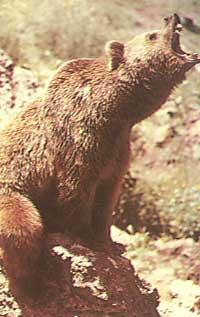Polar bear in danger
2000/10/24 Mendiburu, Joana - Elhuyar Zientziaren Komunikazioa
Although not in danger of extinction, the situation of the polar bear is undergoing major changes. The United States and Russia have just signed the second agreement to protect this big mammal.
Although the polar bear (Thalactos maritimus) is not in danger of extinction, it is under threat. The factors that directly affect their habits and the reproductive process are, among others, the introduction of man in their habitat area, illegal hunting or chemical pollution.
According to researchers of this largest mammal on Earth, the increase in global temperature is directly related to their habitats and hunting habits. As is known, Arctic ice is melting and therefore the natural habitat of bears is decreasing. Also, when large pieces of ice are broken and separated, bears move away from their favorite dish. Being less likely to hunt seals, hungry, bears increasingly attack humans. For example, in the northernmost village of Ny-Alesund in the world, the huge battles of the bears cause the inhabitants not to leave home without hunting weapons. In addition, 60 neighbors have the habit of keeping the doors of their homes permanently open to quickly find shelter after the attack. It is not the best solution since bears have also learned to enter homes. Thus, last July they had to kill the bears who entered a house.
Bear Rivals
Despite the huge size of adult polar bears, this animal also has dangerous enemies. Among other things, although not frequent, it has been hunting for walruses and wolves. On the other hand, despite being an extended idea, male adult bears kill their offspring very rarely. Undoubtedly, the main perpetrators and enemies of most polar bear deaths are the hunters. In recent years around 1,000 heads have died each year, of which 600-700 Inuit hunters and Canadian Indians. Currently, the polar bear population ranges from 20,000 to 40,000 individuals, of whom 15,000 reside in Canada.
In addition to these enemies, bears have another danger. Many polar bears are hermaphrodites, that is, they have male and female ugal organ. According to a study, of the 3,000 bears of the Arctic Svalbard archipelago, 36 are hermaphrodites. Experts discover that more and more females have a excretion in the form of a penis. About ten years ago the first bear hermaphrodite appeared and, in addition to being increasingly abundant, the curious thing is that hermaphroditism attacks mainly females. Analyzing this data, it is said that in the case of taking hermaphroditism is not a genetic problem. This is the direct consequence of polychlorobiphenyl discharges used in electrical installations. This chemical pollution is considered to be swept away by the wind from Europe.
Strict hunting measures
Since 1961, the Canadian Wildlife Service has investigated the ecology of the bear to know its physical characteristics, control its movements and measure toxic pollution. However, international cooperation for animal protection is negative. Since 1965 a group of international scientists has been engaged in conducting research and animal management in the Arctic. In 1973, Canada, Denmark, Norway, the United States and Russia signed the Oslo agreement for the protection of the white bear. An agreement has recently been reached specifying which breeds of animals may die a year, prohibiting the hunting of females with offspring of less than a year, as well as the use of planes and traps for hunting.

Gai honi buruzko eduki gehiago
Elhuyarrek garatutako teknologia





